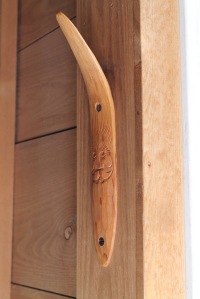When splitting branch crooks for spoons, I often end up with a thin split from the upper portion of the crook. Sometimes such a piece may have potential for a smaller eating spoon, but I also like to use them for wall hooks. It is a quick and simple project; a fun diversion and also a great idea for working with kids.
Of course, a natural branch junction makes a good hook also. Below are a couple examples from my shop walls. The one holding my braces is an extreme natural curve. You can’t pass that up in a brush pile. I’ve seen photos of branch hooks folks have made with lots of funky shapes and painted colors. Lots of creative possibilities.
Making a hook from a spoon crook goes something like this:

The crook has already been split along the pith (the bottom of the piece in this photo). Before further carving of the piece into a spoon, I split a thin crook from the upper portion.

The flat lower portion will go against the wall. I flatten the back further with a knife. A block plane could be used as well.

After a little shaping with a knife, I drill a couple holes as wide as the screw shank, then countersink for the screw heads.
Onto the wall …
and ready for your cap.









Reblogged this on Jgyura's and commented:
What a cool concept of using a limb branch to create a hanger. On my list of to-dos…
LikeLike
Very clever! A good use of less than ideal split wood. Just proves a ‘clever’ mind can make ‘firewood’ aesthetically very pleasing.
LikeLike
what a cool way to make a hook! iam going to try one. thanks for the great post!
LikeLike
I dont know where I first saw these. Since then I have littered my shop with them. Hardly a more charming hook could be found. Nature triumphs again!
LikeLike
Oh, and its real easy to flatten the back if you clamp a wooden jointer plane in a bench vise and go to it.
LikeLike